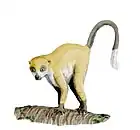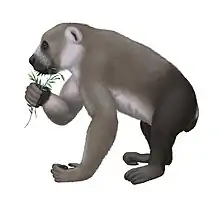Sifaka
A sifaka (/sɪˈfɑːkə/; Malagasy pronunciation: [ˈsifakə̥] ⓘ) is a lemur of the genus Propithecus from the family Indriidae within the order Primates. The name of their family is an onomatopoeia of their characteristic "shi-fak" alarm call.[4] Like all lemurs, they are found only on the island of Madagascar. All species of sifakas are threatened, ranging from endangered to critically endangered.[5]
| Sifakas | |
|---|---|
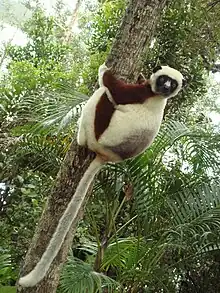 | |
| Coquerel's sifaka (P. coquereli) | |
| Scientific classification | |
| Domain: | Eukaryota |
| Kingdom: | Animalia |
| Phylum: | Chordata |
| Class: | Mammalia |
| Order: | Primates |
| Suborder: | Strepsirrhini |
| Family: | Indriidae |
| Genus: | Propithecus Bennett, 1832[2] |
| Type species | |
| Propithecus diadema Bennett, 1832 | |
| Diversity | |
| 9 species | |
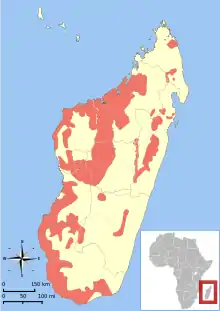 | |
| Combined distribution of Propithecus[3] | |
| Synonyms | |
| |
Anatomy and physiology
Sifakas are medium-sized indriids with a head and body length of 40 to 55 cm (16 to 22 in) and a weight of 3 to 6 kg (6.6 to 13.2 lb). Their tail is just as long as their body, which differentiates them from the Indri. Their fur is long and silky, with coloration varying by species from yellowish-white to blackish-brown. Their round, hairless face is always black. As with all lemurs, the sifaka has special adaptations for grooming, including a toilet-claw on its second toe and a toothcomb.[6]
Sifakas move by vertical clinging and leaping, meaning they maintain an upright position leaping from tree trunk to tree trunk and moving along branches. They are skillful climbers and powerful jumpers, able to make leaps up to 10 m (32.8 ft) from one tree to the next. On the ground, they move like all indrids, with bipedal, sideways hopping movements of the hind legs, holding their fore limbs up for balance.[7] Sifakas are diurnal and arboreal. [8]
Sifakas are herbivores, eating leaves, flowers, and fruits. When not searching for food, they spend a good part of the day sunbathing, stretched on the branches. Sifakas live in larger groups than the other indrids (up to 13 animals). They have a firm territory, which they mark with scent glands. Edges of different sifaka territories can overlap. Though they defend their territory from invasion by others of their species, they may peacefully co-exist with other lemur species such as the red-bellied lemur and the common brown lemur. Successful invasions are known to result in death of male members, group takeover, and infanticide.[9]
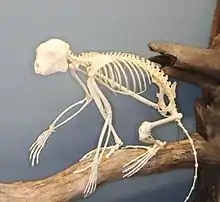
Predators of the sifaka include the fossa, a puma-like mammal native to Madagascar, and aerial hunters such as hawks.[10] The sifaka usually avoids these attacks with its agile acrobatics through the trees high above the ground. However, they have been known to attack by biting and scratching and have even been witnessed fighting off a Madagascar ground boa.[11]
A four- to five-month gestation period ends with the birth of a single offspring in July. The young holds fast to the mother's belly when small, but then later is carried on her back. Young are weaned after about six months and reach full maturity at the age of two to three years. The life expectancy of the sifakas is up to 20 years.[12]
Threats
Conservative estimates show that the utilization of fire for slash and burn cultivation, cattle raising, logging, and mining activities has contributed to the loss of 52% of the forested land since the 1950s, impacting the survival of sifakas. For instance, Perrier's sifaka relies solely on vast forest cover, so little to no institutions are addressing these threats or the species' conservation status.[13]


Classification
_range_map.svg.png.webp)
_range_map.svg.png.webp)
- Family Indriidae
- Genus Indri
- Genus Avahi
- Genus Propithecus[14]
- P. diadema group
- Diademed sifaka, P. diadema
- Milne-Edwards's sifaka, P. edwardsi
- Silky sifaka, P. candidus
- Perrier's sifaka, P. perrieri
- P. verreauxi group
- Coquerel's sifaka, P. coquereli
- Verreaux's sifaka, P. verreauxi
- Von der Decken's sifaka, P. deckenii
- Crowned sifaka, P. coronatus
- Golden-crowned sifaka, P. tattersalli
- P. diadema group
 P. coquereli
P. coquereli P. diadema
P. diadema P. candidus
P. candidus P. edwardsi
P. edwardsi
References
- "Checklist of CITES Species". CITES. UNEP-WCMC. Retrieved 18 March 2015.
- Groves, C. P. (2005). Wilson, D. E.; Reeder, D. M. (eds.). Mammal Species of the World: A Taxonomic and Geographic Reference (3rd ed.). Baltimore: Johns Hopkins University Press. pp. 120–121. ISBN 0-801-88221-4. OCLC 62265494.
- "IUCN 2014". IUCN Red List of Threatened Species. Version 2014.3. International Union for Conservation of Nature. 2012. Retrieved 12 March 2015.
- Norscia, Ivan; Palagi, Elisabetta (2016). The Missing Lemur Link: An Ancestral Step in the Evolution of Human Behaviour. United Kingdom: Cambridge University Press. p. 39. ISBN 978-1-107-01608-8.
- "Almost a third of lemurs and North Atlantic Right Whale now Critically Endangered - IUCN Red List". The IUCN Red List of Threatened Species. 9 July 2020. Retrieved 2021-07-07.
- Schwitzer, C; Mittermeier, R. A.; Louis Jr., E. E.; Richardson, M. C. (2013). "Family Indriidae: woolly lemurs, sifakas and indri)". In Mittermeier, Russell A.; Rylands, Anthony B.; Wilson, Don E. (eds.). Handbook of the Mammals of the World. Volume 3. Primates. Barcelona: Lynx Edicions. ISBN 978-84-96553-89-7.
- "Coquerel's Sifaka". Duke University Lemur Center. Archived from the original on 2013-09-23. Retrieved 2009-06-15.
- "Coquerel's Sifaka". St. Louis Zoo. Retrieved 9 June 2019.
- Brockman, D. K.; Cobden, A. K.; Whitten, P. L. (2009). "Birth season glucocorticoids are related to the presence of infants in sifaka (Propithecus verreauxi)". Proceedings of the Royal Society B: Biological Sciences. 276 (1663): 1855–63. doi:10.1098/rspb.2008.1912. PMC 2674497. PMID 19324777.
- "Descriptions and articles about the Coquerel's Sifaka (Propithecus coquereli) - Encyclopedia of Life". Encyclopedia of Life. Retrieved 2015-09-29.
- "Bring it on: Sifaka lemurs take down a three-metre boa in Madagascar | predator-vs-prey | Earth Touch News". Retrieved 2015-09-29.
- "Coquere's Sifaka". New England Primate Conservancy. Retrieved 2020-02-04.
- Salmona, J.; Teixeira, H.; Rasolondraibe, E.; Aleixo-Pais, I.; Kun-Rodrigues, C.; Rakotonanahary, A. N.; Jan, F.; Rabarivola, C. J.; Zaonarivelo, J. R.; Andriaholinirina, N. V.; Chikhi, L. (2015). "Genetic Diversity, Population Size, and Conservation of the Critically Endangered Perrier's Sifaka (Propithecus perrieri)". International Journal of Primatology. 36 (6): 1132–1153. doi:10.1007/s10764-015-9881-x. S2CID 17919181.
- Groves, C.P.; Helgen, K.M. (2007). "Craniodental characters in the taxonomy of Propithecus" (PDF). International Journal of Primatology. 28 (6): 1363–1383. doi:10.1007/s10764-007-9226-5. hdl:1885/35492. S2CID 22899861.
